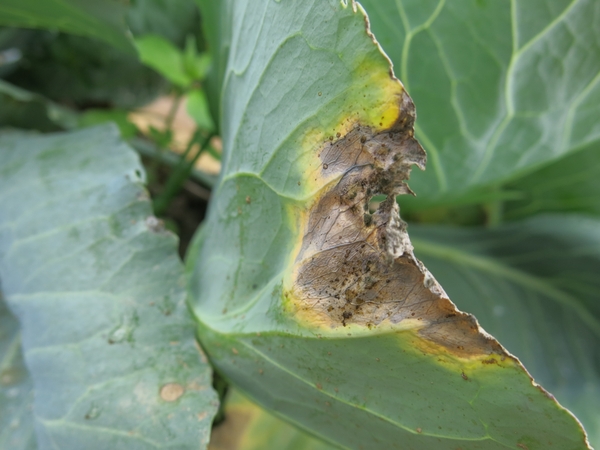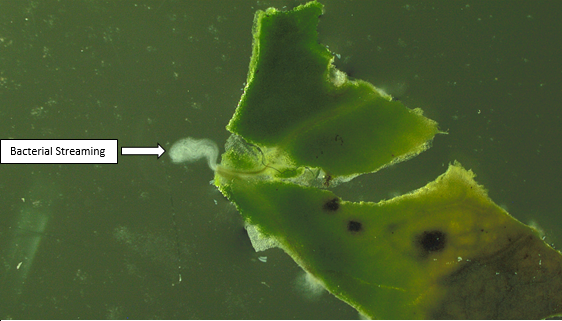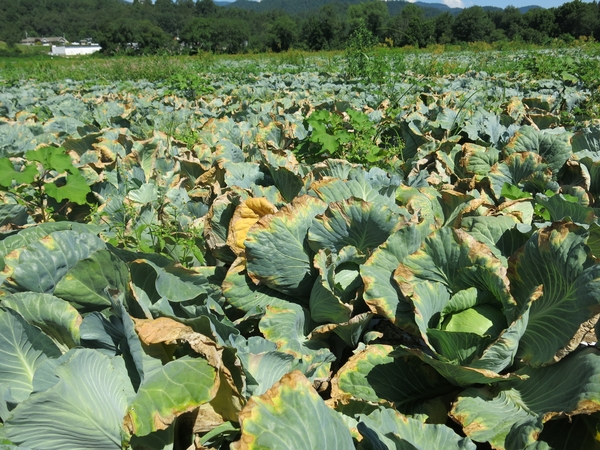Introduction
Black rot is a disease of brassicas (Brassicaceae) that occurs worldwide and can result in high losses of yield and quality.
Pathogen
The disease is caused by the seed-borne bacterium Xanthomonas campestris pv. campetris. Other pathovars of X. campestris also cause leaf spots on brassicas, but X. campestris pv. campestris is the predominant pathovar causing black rot on Brassiacas.
Distribution and Host Range
Black rot occurs worldwide and can impact virtually all brassica crops, including bok choy, broccoli, brussel sprouts, cabbage, cauliflower, collards, kale, rutabaga, radish, and turnip. Additionally, cruciferous weeds (shepherd’s purse and wild mustard) can harbor the disease and may contribute to outbreaks in warmer climates.
Symptoms and Signs
The most common symptom of black rot are yellow, v-shaped lesions that extend toward the base of the leaf that eventually lead to wilt and necrosis. Symptoms can appear similar to drought stress, overwatering, or excessive fertilizer application. However, within lesions and in adjacent areas, distinct blackening of veins indicative of black rot may occur (Fig. 1). Root crops may not have visible symptoms on above ground tissues, but blackened veins will develop on the roots. As the disease progresses and spreads to the stem, the inner tissue becomes black and the flow of water and nutrients is inhibited leading to plant death. A good indicator of bacterial infection is bacterial streaming (Fig. 2). If you have access to a microscope, place a freshly cut piece of leaf tissue that spans the margin of the lesion in water. Allow it to sit for 3-5 minutes and watch for a stream of white substance (bacteria) exiting the plant tissue.
Lookalike Diseases
Fusarium wilt and Verticillium wilt can infect brassica crops, as well, and may be confused for black rot, although these diseases are rarely observed on Brassicas in North Carolina. However, both Fusarium and Verticillium wilt will cause a distinctive yellowing on one side of the effected plant or leaf. Additionally, neither disease will develop blackened veins within their lesions which is indicative of black rot.
Disease Cycle and Epidemiology
The most common source of disease inoculum to a field is through infected seed, but transmission within the field primarily occurs through splashing water and the movement of people and equipment. The bacterium will enter into open pores at the margins of the leaf (hydrathodes), as well as through wounds caused by pests and other mechanical injuries. Plants are susceptible at any growth stage, and disease often occurs during wet, warmer (80 – 86°F) weather. Eventually, the pathogen can become systemic and spread to the stem or root tissues. Water conducting vessels within the stem become blocked with a mucilaginous sugar produced by the bacterium, inhibiting water and nutrients from reaching upper parts of the plant. This bacteria can persist independently in the soil for 40 – 60 days and up to 2 years on infected plant debris. Brassica weeds also may contribute to outbreaks in warmer climates.
General Disease Management
Symptoms of black rot often occur more than a week after the infection has become established when control is much harder to achieve. The cultural practices listed below are critical to the prevention of black rot.
- Select resistant or tolerant cultivars. For fields with a history of black rot, planting resistant varieties can reduce severe symptoms of disease. See the Southeastern US Vegetable Crop Handbook for a list of varieties with resistance or tolerance. Some strains of the bacterium can overcome resistance, however, so black rot may still be observed.
- Purchase certified disease free seeds. The most common source of inoculum is through infected seed. If unable to purchase disease-free seeds, the seed may be treated with hot water to eliminate the pathogen, but care must be taken in using this strategy or it can kill the seed.
- Destroy crop residues. Immediately removing infected plant material is important to discourage the persistence of the pathogen.
- Maintain a 3-4 year crop rotation. Implementing crop rotation to a non-host for at least 3 years is recommended to reduce disease spread and persistence.
- Avoid overhead irrigation and handling plants in wet conditions. Splashing water and handling of plants while they are wet may disperse bacteria over short distances and increase likelihood of spread.
- Manage weed populations. Weeds within the Brassicaceae, such as shepherd’s purse and wild mustard, can harbor disease and should be removed immediately to prevent introduction.
- Reduce mechanical injuries to plants. The pathogen enters the plant through natural openings and mechanical injuries. Decreasing these colonization opportunities will help prevent disease.
- Sanitation. Always sanitize boots and equipment when moving between fields if any have a history of black rot.
Disease Management for Conventional Growers
Following the management strategies listed above is crucial and the most effective way to discourage black rot. Bactericides are only marginally effective once disease is established. However, products containing the active ingredient acibenzolar-S-methyl (Actigard) are rated as fairly effective against black rot, if used preventatively. Additionally, copper-based products tank mixed with mancozeb can be used in the field or greenhouse. The addition of streptomycin may help minimize disease on transplants in the greenhouse. However, resistance to copper and streptomycin is known to occur in this pathogen, so rotation of the products is critical for efficacy.
Disease Management for Organic Growers
Following the management strategies listed above is crucial and the most effective way to discourage black rot. However, fixed copper treatments have been shown to be somewhat effective against black rot when applied at the correct time and if copper resistant strains are not present. If possible, treat when weather conditions are ideal for disease rather than following a calendar spray program.
Additional Resources
- The NC State Plant Disease and Insect Clinic provides diagnostics and control recommendations
- The NC State Extension Plant Pathology portal provides information on crop disease management
- The Southeastern US Vegetable Crop Handbook provides information on vegetable disease management
Publication date: Feb. 23, 2022
N.C. Cooperative Extension prohibits discrimination and harassment regardless of age, color, disability, family and marital status, gender identity, national origin, political beliefs, race, religion, sex (including pregnancy), sexual orientation and veteran status.



